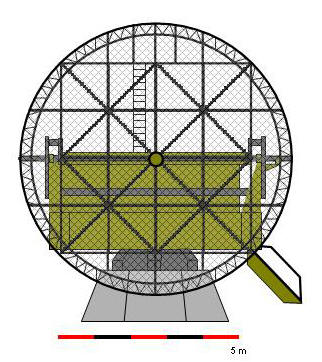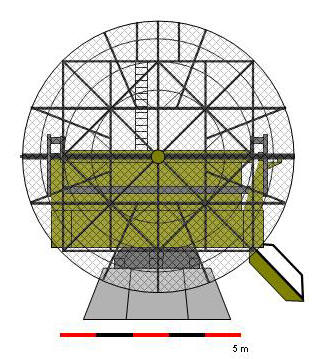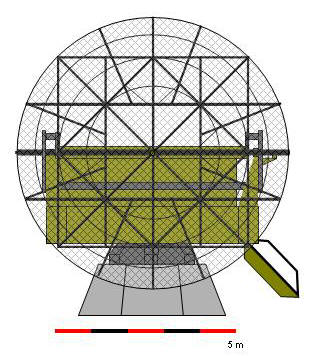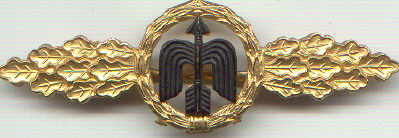| |
|
|
| |
|
|
| |
Luftwaffe
radar types
recognition guide. |
|
| |
|
|
|
|
| |
Back |
|
| |
|
|
| |
RADARS WITH ALPHA SCOPE DISPLAY IN THE OPERATORS CABIN. |
|
| |
The radars depicted below were among the first models deployed. The operators were housed in the
cabin, slewed the radar manually and measured range and bearing to a track on a number of Alpha-scopes and corresponding scales. The range and bearing readings were reported to the Stellung Auswertung, where they were plotted on a map, with the aid of a
range & bearing ruler (Spinne). The arrangement of the antennas were standardized. The lower antenna was for the receiver, the next for the transmitter and the third for the interrogator (Abfragesenders "Kuh"), the Luftwaffe
equivalent of the Allied Identification Friend or Foe (IFF). Both the reflected signal and the transponder response was received by the lower antenna. The radar transmitted a beam, which was narrow in azimuth and wide in elevation. |
|
| |
Some of the radars depicted below are not very well described in the
published literature - if at all. The problem is exacerbated by the
fact, that they often are incorrectly designated in the original German
documents and allied post-war reports. These radars are designated
with an * and the caption is in a white font. |
|
| |
|
|
| |
.jpg) |
|
.jpg) |
|
| |
FuMG 450 Freya A/N, 2 antennas, 4 rows of vertical dipoles, 6 in each row. |
|
FuMG (Flum) 41 G (k3B) Freya-Köthen K 3, "Gross Freya",
2 antennas, 4 rows of
vertical dipoles, 6 in each row *. |
|
| |
|
|
|
|
| |
|
|
|
|
| |
.jpg) |
|
.jpg) |
|
| |
FuMG (Flum) 42 A (fB) Freya Z, 2 antennas, 4 rows of vertical dipoles, 6 in each row. I.a.w. published sources this was only built as a prototype. Recently, however, we became aware of a photo of a field deployed unit.
* |
|
FuMG 401 Freya LZ A, 3 antennas, 6 rows of vertical dipoles, 6 in each row. |
|
| |
|
|
|
|
| |
|
|
|
|
| |
.jpg) |
|
.jpg) |
|
| |
Cmdr. (RNN)
Jan Egil Fjørtoft was kind enough to make me aware of this early model of an
air transportable radar (DeTe-f), deployed during the occupation of Norway in 1940.
It is documented in: "GEMA-BERLIN" by Herr. Harry von Kroge pp.108 - 109 and
206. The drawing depicts
an attempt at a reconstruction,
based on a frequency of 125 Mhz, which drives the length of the dipoles and
the size of the reflectors *. |
|
FuMG 401 Freya LZ C, 3 antennas, 6 rows of vertical dipoles, 6 in each row. |
|
| |
|
|
|
|
| |
|
|
|
|
| |
.jpg) |
|
.jpg) |
|
| |
FuMG ??? Yagi-Freya. |
|
FuMG ???
Only one picture is known presumably from STAR *. |
|
|
|
|
|
|
|
|
|
|
|
|
|
| |
RADARS WITH PPI DISPLAY IN ADJACENT BUILDING. |
|
| |
The radars below were introduced in 1944. The antenna was driven by an electrical motor and turned
continuously. The operators were housed in a nearby building/ bunker and the display was on a PPI. The arrangement of the antennas followed the principle described above. |
|
| |
|
|
| |
|
|
|
|
| |
.jpg) |
|
.jpg) |
|
| |
FuMG ??? Dreh-Freya, 3 antennas, 1 with 2 rows of 8 vertical, wide-band dipoles, 2 with 2 rows of 8 horizontal, wide-band dipoles. |
|
FuMG ??? Freya Verbunkert, 3 antennas, 1 with 2 rows of 8 vertical, wide-band dipoles, 2 with 2 rows of 6 vertical, narrow-band dipoles .
Only one photo has hitherto been found, but the bunker and the foundation
has been found on a number of locations in The Netherlands and in Denmark *. |
|
|
|
|
|
|
|
| |
|
|
| |
SECONDARY RADARS. |
|
| |
The above modern expression encompasses radars, that do not send out a pulse and receive
a reflected signal. These types transmit an interrogation signal, which is received in the aircraft, where it triggers the on-board equipment ("Erstling") to transmit a response. These radars were used in Jägerleit Stellungen for fighter control
and for assistance of bombers for "blind-bombing". |
|
| |
|
|
| |
|
|
| |
.jpg) |
|
.jpg) |
|
| |
FuS An 730 Freya EGON 1, 2 antennas, 4 rows of vertical dipoles, 6 in each row. |
|
Freya EGON-Jagd, 2 antennas, 4 rows of vertical dipoles, 8 in each row. |
|
| |
|
|
|
|
| |
|
|
|
|
| |
SECONDARY RADARS, EXPLOITATION OF ALLIED TRANSPONDERS. |
|
| |
The Freya-Flamme was designed to trigger the Allied IFF, or merely receive the response
from an Allied transponder, triggered by an Allied interrogator. |
|
| |
|
|
|
|
| |
|
|
|
|
| |
.jpg) |
|
|
|
| |
FuMG 451 Freya Flamme, 2 antennas, 4 rows of vertical dipoles, 8 in
each row, this is the only sure recognition feature. |
|
|
|
| |
|
|
|
|
| |
|
|
|
|
| |
TARGET
TRACKING RADARS. |
|
| |
|
|
|
|
| |
FuSE 65 Würzburg-Riese. |
|
| |
The
below
types of radars existed
in a total of 4 variants. |
|
| |
|
|
| |
 |
|
 |
|
| |
Reflector Type 1. The
most common in Luftwaffe Stellungen. |
|
Reflector Type 2.
Occasionally seen in Stellungen in Eastern Europe. |
|
| |
|
|
|
|
| |
 |
|
.jpg) |
|
| |
Reflector Type 3.
Occasionally seen in Stellungen in Eastern Europe. |
|
Reflector Type 4. This
version was named Grauechse and worked on a frequency of 350 Mhz. It
is uncertain if it was ever operationally deployed. * |
|
| |
|
|
|
|
| |
|
|
|
|
| |
|
|
|
|
| |
Back |
|
| |
|
|
|
|
| |
|
|
|
|
| |
 |
|
| |
|
|
|
|
| |
|
|
|
|
.jpg)
.jpg)
.jpg)
.jpg)
.jpg)
.jpg)
.jpg)
.jpg)
.jpg)
.jpg)
.jpg)
.jpg)
.jpg)



.jpg)